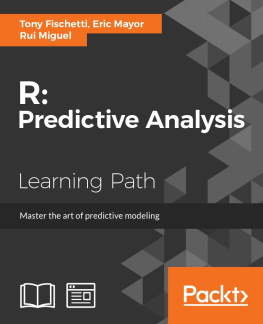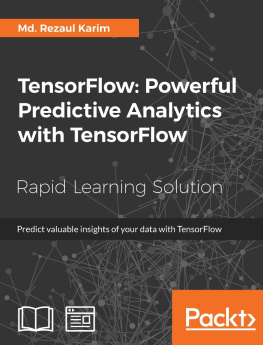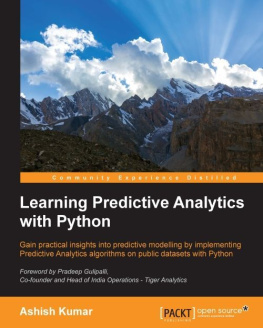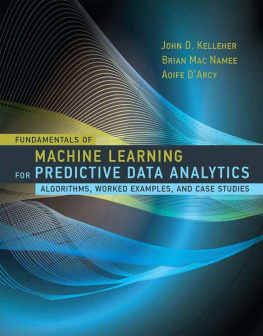Ajit C Tamhane - Predictive Analytics: Parametric Models for Regression and Classification Using R
Here you can read online Ajit C Tamhane - Predictive Analytics: Parametric Models for Regression and Classification Using R full text of the book (entire story) in english for free. Download pdf and epub, get meaning, cover and reviews about this ebook. year: 2020, genre: Children. Description of the work, (preface) as well as reviews are available. Best literature library LitArk.com created for fans of good reading and offers a wide selection of genres:
Romance novel
Science fiction
Adventure
Detective
Science
History
Home and family
Prose
Art
Politics
Computer
Non-fiction
Religion
Business
Children
Humor
Choose a favorite category and find really read worthwhile books. Enjoy immersion in the world of imagination, feel the emotions of the characters or learn something new for yourself, make an fascinating discovery.

- Book:Predictive Analytics: Parametric Models for Regression and Classification Using R
- Author:
- Genre:
- Year:2020
- Rating:4 / 5
- Favourites:Add to favourites
- Your mark:
- 80
- 1
- 2
- 3
- 4
- 5
Predictive Analytics: Parametric Models for Regression and Classification Using R: summary, description and annotation
We offer to read an annotation, description, summary or preface (depends on what the author of the book "Predictive Analytics: Parametric Models for Regression and Classification Using R" wrote himself). If you haven't found the necessary information about the book — write in the comments, we will try to find it.
Ajit C Tamhane: author's other books
Who wrote Predictive Analytics: Parametric Models for Regression and Classification Using R? Find out the surname, the name of the author of the book and a list of all author's works by series.
Predictive Analytics: Parametric Models for Regression and Classification Using R — read online for free the complete book (whole text) full work
Below is the text of the book, divided by pages. System saving the place of the last page read, allows you to conveniently read the book "Predictive Analytics: Parametric Models for Regression and Classification Using R" online for free, without having to search again every time where you left off. Put a bookmark, and you can go to the page where you finished reading at any time.
Font size:
Interval:
Bookmark:
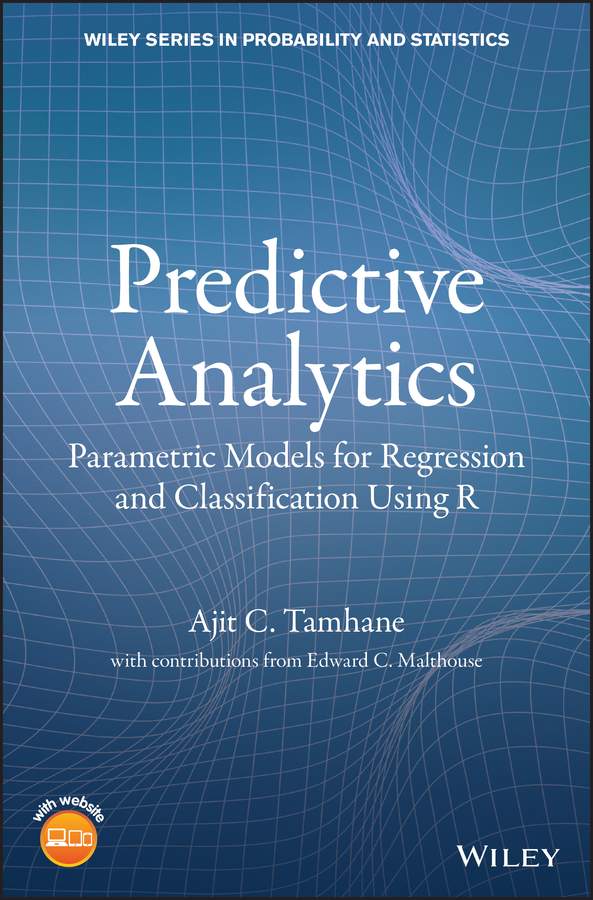
- Chapter 2
- Chapter 3
- Chapter 4
- Chapter 6
- Chapter 7
- Chapter 9
- Chapter 10
- Chapter 2
- Chapter 3
- Chapter 4
- Chapter 5
- Chapter 6
- Chapter 7
- Chapter 8
- Chapter 9
- Chapter 10
Established by Walter A. Shewhart and Samuel S. Wilks
Editors: David J. Balding, Noel A. C. Cressie, Garrett M. Fitzmaurice, Geof H. Givens, Harvey Goldstein, Geert Molenberghs, David W. Scott, Adrian F. M. Smith, Ruey S. Tsay
Editors Emeriti: J. Stuart Hunter, Iain M. Johnstone, Joseph B. Kadane, Jozef L. Teugels
The Wiley Series in Probability and Statistics is well established and authoritative. It covers many topics of current research interest in both pure and applied statistics and probability theory. Written by leading statisticians and institutions, the titles span both state-of-the-art developments in the field and classical methods.
Reflecting the wide range of current research in statistics, the series encompasses applied, methodological and theoretical statistics, ranging from applications and new techniques made possible by advances in computerized practice to rigorous treatment of theoretical approaches. This series provides essential and invaluable reading for all statisticians, whether in academia, industry, government, or research.
A complete list of titles in this series can be found at http://www.wiley.com/go/wsps
Ajit C. Tamhane
Northwestern University
with contributions from Edward C. Malthouse, Northwestern University

Copyright
This edition first published 2021
2021 John Wiley & Sons, Inc
All rights reserved. No part of this publication may be reproduced, stored in a retrieval system, or transmitted, in any form or by any means, electronic, mechanical, photocopying, recording or otherwise, except as permitted by law. Advice on how to obtain permission to reuse material from this title is available at http://www.wiley.com/go/permissions.
The right of Ajit C. Tamhane to be identified as the author of this work has been asserted in accordance with law.
Registered Office
John Wiley & Sons, Inc., 111 River Street, Hoboken, NJ 07030, USA
Editorial Office
John Wiley & Sons, Inc., 111 River Street, Hoboken, NJ 07030, USA
For details of our global editorial offices, customer services, and more information about Wiley products visit us at www.wiley.com.
Wiley also publishes its books in a variety of electronic formats and by printondemand. Some content that appears in standard print versions of this book may not be available in other formats.
Limit of Liability/Disclaimer of Warranty
While the publisher and authors have used their best efforts in preparing this work, they make no representations or warranties with respect to the accuracy or completeness of the contents of this work and specifically disclaim all warranties, including without limitation any implied warranties of merchantability or fitness for a particular purpose. No warranty may be created or extended by sales representatives, written sales materials or promotional statements for this work. The fact that an organization, website, or product is referred to in this work as a citation and/or potential source of further information does not mean that the publisher and authors endorse the information or services the organization, website, or product may provide or recommendations it may make. This work is sold with the understanding that the publisher is not engaged in rendering professional services. The advice and strategies contained herein may not be suitable for your situation. You should consult with a specialist where appropriate. Further, readers should be aware that websites listed in this work may have changed or disappeared between when this work was written and when it is read. Neither the publisher nor authors shall be liable for any loss of profit or any other commercial damages, including but not limited to special, incidental, consequential, or other damages.
Library of Congress CataloginginPublication Data
Names: Tamhane, Ajit C., author.
Title: Predictive analytics : parametric models for regression and
classification using R / Ajit C. Tamhane, Northwestern University ; with
contributions from Edward C. Malthouse, Northwestern University.
Description: Hoboken, NJ : Wiley, 2020. | Series: Wiley series in
probability and statistics | Includes index.
Identifiers: LCCN 2020034678 (print) | LCCN 2020034679 (ebook) | ISBN
9781118948897 (cloth) | ISBN 9781118948910 (adobe pdf) | ISBN
9781118948903 (epub)
Subjects: LCSH: Data mining Statistical methods. | Probabilities. | R
(Computer program language)
Classification: LCC QA76.9.D343 T349 2020 (print) | LCC QA76.9.D343
(ebook) | DDC 006.3/12 dc23
LC record available at https://lccn.loc.gov/2020034678
LC ebook record available at https://lccn.loc.gov/2020034679
Cover Design: Wiley
Cover Image: draganab/Getty Images
To All My Students
From Whom I Have Learned More
Than I Have Taught Them
We are living in a highly datarich environment, popularly referred to as the world of Big Data. This book is my attempt to present the classical methods of parametric regression and classification in the context of this world. Data analytics commonly refers to modern computer intensive methods such as classification and regression trees (CART), random forests, deep learning, support vector machines, and so on. However, the knowledge of classical methods covered in this book is still essential for a sound foundation. They also provide simpler solutions in many cases. The main distinguishing and attractive feature of the book is that it covers a broad range of parametric methods, including multiple regression, logistic regression (binary and multinomial), discriminant analysis, generalized linear models, and survival analysis. The presentation is streamlined so that these topics can be covered in a single course. The book is primarily aimed at graduate students in statistics, data science, and applied fields such as marketing, engineering, and so on, as well as at practitioners in these disciplines.
Although the book covers mainly classical parametric methods, I have added short sections in several chapters briefly reviewing modern computer intensive extensions. The idea of these sections is to provide sneak previews of these methods, which students may want to learn in more detail and use them as possible alternatives to classical methods. For example, we briefly review regression trees and neural nets in the multiple regression chapter and classification trees and support vector machines in the logistic regression chapter.
There are many excellent texts on classical regression, for example, Chatterjee and Hadi (2012) and Montgomery et al. (2012) on multiple regression and Hosmer and Lemeshow (1989) on logistic regression. However, I have felt the need to modernize the presentations and use larger data sets with business applications of interest to many of our students. At the same time, the core of these classical methods needs to be presented rigorously. To balance these two somewhat conflicting needs, I have put the technical details, such as derivations and proofs of the results, in the technical notes section of each chapter. The main body of the text is devoted to real data examples with only the necessary statistical methodology details included. Frequently, I have used small data sets as they are often helpful for pedagogical purposes. I have also separated the exercises into theoretical and applied. This format allows the book to be used in both masters and PhD classes. Masters classes may skip the Technical Notes sections and most of the theoretical exercises, while PhD classes may use both theoretical and applied parts of the book, emphasizing the former. Prospective instructors may consider using the book in this manner for these two groups of students. The choice of sections and exercises to skip or include would depend upon the interests of the instructor and students.
Next pageFont size:
Interval:
Bookmark:
Similar books «Predictive Analytics: Parametric Models for Regression and Classification Using R»
Look at similar books to Predictive Analytics: Parametric Models for Regression and Classification Using R. We have selected literature similar in name and meaning in the hope of providing readers with more options to find new, interesting, not yet read works.
Discussion, reviews of the book Predictive Analytics: Parametric Models for Regression and Classification Using R and just readers' own opinions. Leave your comments, write what you think about the work, its meaning or the main characters. Specify what exactly you liked and what you didn't like, and why you think so.

